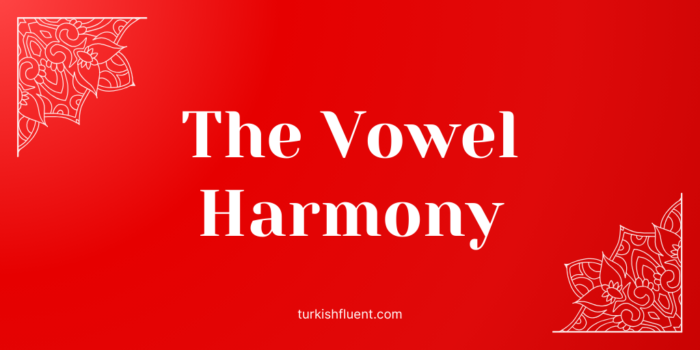Table of Contents
Introduction
What is Vowel Harmony?
Vowel harmony is a fundamental aspect of the Turkish language, ensuring that vowels within a word are compatible with one another. This linguistic feature plays a crucial role in maintaining phonetic coherence and smoothness in speech. Understanding and mastering vowel harmony is essential for anyone learning Turkish, as it affects word formation and pronunciation.
Types of Vowels in Turkish
As mentioned in our Turkish alphabet article, there are 8 vowels in Turkish: a, e, ı, i, o, ö, u and ü.
The Turkish vowel harmony is ruled by how you form vowel sounds with your tongue and mouth. There are three different variables:
- Front vs. Back Vowels: This classification is based on the position of the tongue:
- Front vowels (e, i, ö, ü) are produced with the tongue positioned closer to the front of the mouth ;
- Back vowels (a, ı, o, u) are articulated with the tongue pulled back.
- Open vs. Closed Vowels: This distinction refers to how much space you leave between your tongue and the roof of your mouth.
- Open vowels (a, e) have more space ;
- Closed vowels (ı, i, u, ü) have less space.
- Unrounded vs. Rounded Vowels: This category is determined by the shape of the lips.
- Unrounded vowels (a, e, ı, i) are pronounced with relaxed lips ;
- Rounded vowels (o, ö, u, ü) involve rounding the lips.
Turkish vowel harmony is generally divided into two main types: e-type vowel harmony and i-type vowel harmony. These types determine the form of suffixes added to words based on the last vowel in the root word. Each type is used for different cases.
II – E-type Vowel Harmony
2.1 Definition and Explanation
E-type vowel harmony, also known as “large vowel harmony,” is based on the distinction between front and back vowels. It dictates that the vowels in the suffixes should match the type of the last vowel in the root word. If the last vowel in the root word is a front vowel, the suffix will also contain front vowels. Conversely, if the last vowel is a back vowel, the suffix will contain back vowels.
Here are the rules for e-type vowel harmony:
- If the last vowel in the word is a, ı, o, or u, use the a form.
- If the last vowel in the word is e, i, ö, or ü, use the e form.
2.2 Examples and Usage
E-type vowel harmony is used in the following cases:
- Plural Suffix: -ler / -lar
- “ev” (house) + “-ler” = “evler” (houses) (e => e ; front vowel harmony)
- “kitap” (book) + “-lar” = “kitaplar” (books) (a => a ; back vowel harmony)
- Dative Case Suffix: -e / -a
- “anne” (mother) + “-e” = “anneye” (to the mother) (e => e ; front vowel harmony)
- “araba” (car) + “-a” = “arabaya” (to the car) (a => a ; back vowel harmony)
- Locative Case Suffix: -de / -da
- “şehir” (city) + “-de” = “şehirde” (in the city) (i => e ; front vowel harmony)
- “oda” (room) + “-da” = “odada” (in the room) (a => a ; back vowel harmony)
- Ablative Case Suffix: -den / -dan
- “göl” (lake) + “-den” = “gölden” (from the lake) (ö => e ; front vowel harmony)
- “ağaç” (tree) + “-dan” = “ağaçtan” (from the tree) (a => a ; back vowel harmony)
- Negative Adjective Suffix: -siz / -sız / -süz / -suz
- “su” (water) + “-suz” = “susuz” (without water) (u => u ; back vowel harmony)
- “ışık” (light) + “-sız” = “ışıksız” (without light) (ı => ı ; back vowel harmony)
- “gül” (rose) + “-süz” = “gülsüz” (without roses) (ü => ü ; front vowel harmony)
- “ev” (house) + “-siz” = “evsiz” (without a house) (e => i ; front vowel harmony)
III – I-type Vowel Harmony
3.1 Definition and Explanation
I-type vowel harmony, or “small vowel harmony,” distinguishes between rounded and unrounded vowels. If the last vowel in the root word is a rounded vowel, the suffix will also contain rounded vowels. If the last vowel is unrounded, the suffix will have unrounded vowels.
Here are the rules for i-type vowel harmony:
- If the last vowel in the word is e or i, use the i form.
- If the last vowel in the word is a or ı, use the ı form.
- If the last vowel in the word is o or u, use the u form.
- If the last vowel in the word is ö or ü, use the ü form.
3.2 Examples and Usage
I-type vowel harmony is used in the following cases:
- Possessive Suffixes (2nd person singular -in / -ın / -ün / -un):
- “ev” (house) + “-in” = “evin” (your house) (e => i ; unrounded vowel harmony)
- “okul” (school) + “-un” = “okulun” (your school) (u => u ; rounded vowel harmony)
- Possessive Suffixes (1st person singular -im / -ım / -üm / -um):
- “kitap” (book) + “-ım” = “kitabım” (my book) (a => ı ; unrounded vowel harmony)
- “gül” (rose) + “-üm” = “gülüm” (my rose) (ü => ü ; rounded vowel harmony)
- Accusative Case Suffix (-i / -ı / -ü / -u):
- “kedi” (cat) + “-yi” = “kediyi” (the cat) (i => i ; unrounded vowel harmony)
- “su” (water) + “-yu” = “suyu” (the water) (u => y ; rounded vowel harmony)
- Genitive Case Suffix (-in / -ın / -ün / -un):
- “ev” (house) + “-in” = “evin” (of the house) (e => i ; unrounded vowel harmony)
- “okul” (school) + “-un” = “okulun” (of the school) (u => u ; rounded vowel harmony)
- Adjective Suffix (-li / -lı / -lü / -lu):
- “şeker” (sugar) + “-li” = “şekerli” (with sugar) (e => i ; unrounded vowel harmony)
- “yağ” (oil) + “-lı” = “yağlı” (with oil) (a => ı ; unrounded vowel harmony)
- “göl” (lake) + “-lü” = “göllü” (with a lake) (ö => ü ; rounded vowel harmony)
- “bal” (honey) + “-lı” = “ballı” (with honey) (a => ı ; unrounded vowel harmony)
- Question Suffix (-mi / -mı / -mü / -mu):
- “ev” (house) + “-mi?” = “ev mi?” (is it a house?) (e => i ; unrounded vowel harmony)
- “oda” (room) + “-mı?” = “oda mı?” (is it a room?) (a => ı ; unrounded vowel harmony)
- “gül” (rose) + “-mü?” = “gül mü?” (is it a rose?) (ü => ü ; rounded vowel harmony)
- “su” (water) + “-mu?” = “su mu?” (is it water?) (u => u ; rounded vowel harmony)
IV – Exceptions and Irregularities
While vowel harmony is a general rule in Turkish, there are some exceptions, especially with loanwords (words borrowed from other languages). Here are some common exceptions and irregularities:
- “kalp” (heart) + “-ler” = “kalpler” (hearts)
- “hayal” (dream) + “-ler” = “hayaller” (dreams)
- “alkol” (alcohol) + “-ler” = “alkoller” (alcohols)
- “seyahat” (travel) + “-ler” = “seyahatler” (travels)
- “saat” (clock) + “-ler” = “saatler” (clocks)
Conclusion
The vowel harmony is one of the basic rules of Turkish language. If it seems hard at first sight, no worries, you will learn it by reading and practicing. Here is a summary of the Turkish vowel harmony rules:
| Last Vowel in Root Word | e-type Vowel Harmony (Dative) | i-type Vowel Harmony (Accusative) |
| a (araba) | a (arabaya) | ı (arabayı) |
| e (ev) | e (eve) | i (evi) |
| ı (sıra) | a (sıraya) | ı (sırayı) |
| i (gemi) | e (gemiye) | i (gemiyi) |
| o (okul) | a (okula) | u (okulu) |
| ö (göl) | e (göle) | ü (gölü) |
| u (su) | a (suya) | u (suyu) |
| ü (gül) | e (güle) | ü (gülü) |
Next read: The consonant harmony in Turkish.


Pretty sure you made a mistake placing the Negative Adjective Suffix in the e-type examples?
Merhaba Jeremy,
You are right. I removed the wrong one (elma) and added one with the -siz suffix.
Thanks,
Nicolas